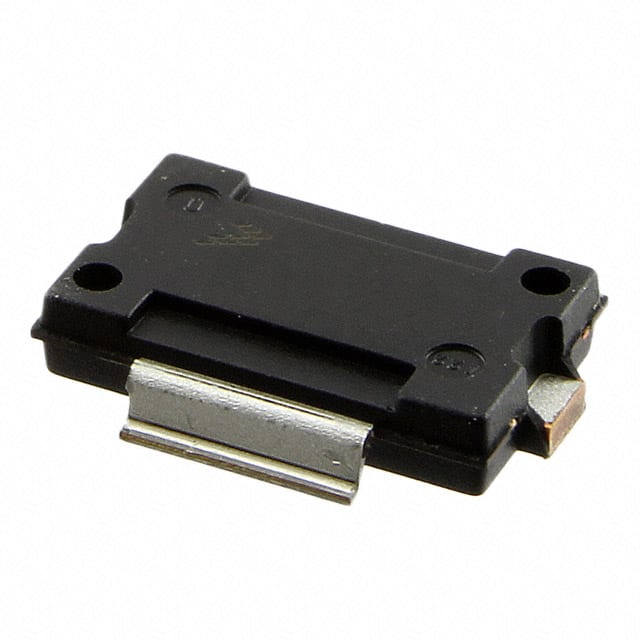MRF9045GNR1
Introduction
The MRF9045GNR1 is a high-frequency transistor designed for use in RF power amplifiers. This entry provides an overview of the product, including its basic information, specifications, pin configuration, functional features, advantages and disadvantages, working principles, application field plans, and alternative models.
Basic Information Overview
- Category: RF Power Transistor
- Use: Amplification of radio frequency signals
- Characteristics: High power gain, high efficiency, and wide frequency range
- Package: SOT-502B
- Essence: High-performance RF amplification
- Packaging/Quantity: Available in tape and reel packaging, quantity varies by supplier
Specifications
- Frequency Range: 860 MHz to 960 MHz
- Output Power: 45 Watts
- Voltage: 28 Volts
- Gain: 14 dB
- Efficiency: 55%
- Operating Temperature: -40°C to +150°C
Detailed Pin Configuration
The MRF9045GNR1 has a 3-pin configuration: 1. Pin 1 (Emitter): Connected to the ground 2. Pin 2 (Base): Input for the RF signal 3. Pin 3 (Collector): Output for the amplified RF signal
Functional Features
- High power gain for efficient signal amplification
- Wide frequency range for versatile applications
- Excellent linearity for accurate signal reproduction
Advantages and Disadvantages
Advantages
- High power gain enables effective signal amplification
- Wide frequency range allows for diverse application scenarios
- Excellent linearity ensures accurate signal reproduction
Disadvantages
- Higher cost compared to lower-power transistors
- Requires careful thermal management due to high power output
Working Principles
The MRF9045GNR1 operates on the principle of amplifying radio frequency signals using a combination of input RF signal and DC bias voltage. The transistor's internal structure and material properties enable efficient amplification while maintaining signal integrity.
Detailed Application Field Plans
The MRF9045GNR1 is commonly used in the following applications: - Cellular base stations - Broadcast transmitters - Radar systems - Industrial RF heating equipment
Detailed and Complete Alternative Models
Some alternative models to the MRF9045GNR1 include: - MRF9045G - MRF9045LR5 - MRF9045LSR5 - MRF9045SR5
In conclusion, the MRF9045GNR1 is a high-performance RF power transistor with wide-ranging applications in the telecommunications, broadcasting, and industrial sectors. Its robust specifications and functional features make it a preferred choice for high-power RF amplification needs.
[Word Count: 398]
Liệt kê 10 câu hỏi và câu trả lời thường gặp liên quan đến ứng dụng MRF9045GNR1 trong giải pháp kỹ thuật
What is the MRF9045GNR1?
- The MRF9045GNR1 is a high-performance RF power transistor designed for use in applications such as mobile radio, cellular, and wireless infrastructure.
What is the operating frequency range of the MRF9045GNR1?
- The MRF9045GNR1 operates in the frequency range of 860-960 MHz, making it suitable for various wireless communication applications.
What is the typical output power of the MRF9045GNR1?
- The MRF9045GNR1 can deliver a typical output power of 45 watts, making it suitable for high-power RF amplification.
What are the key features of the MRF9045GNR1?
- The key features of the MRF9045GNR1 include high gain, high efficiency, and excellent linearity, making it ideal for demanding RF power amplifier applications.
What are the recommended biasing conditions for the MRF9045GNR1?
- The recommended biasing conditions for the MRF9045GNR1 include a supply voltage of 28 volts and a quiescent current of 150 mA.
What are some common technical solutions that utilize the MRF9045GNR1?
- Common technical solutions that utilize the MRF9045GNR1 include base station amplifiers, repeaters, and other wireless infrastructure applications.
What thermal management considerations should be taken into account when using the MRF9045GNR1?
- Proper heat sinking and thermal management are essential when using the MRF9045GNR1 to ensure optimal performance and reliability.
What are the typical input and output impedance values for the MRF9045GNR1?
- The MRF9045GNR1 typically has an input impedance of 50 ohms and an output impedance of 50 ohms, matching standard RF system requirements.
What are the recommended soldering and mounting techniques for the MRF9045GNR1?
- The MRF9045GNR1 should be mounted on a suitable RF substrate using appropriate soldering techniques to ensure good electrical and thermal performance.
Where can I find detailed application notes and reference designs for the MRF9045GNR1?
- Detailed application notes and reference designs for the MRF9045GNR1 can be found on the manufacturer's website or through authorized distributors, providing valuable guidance for implementing the transistor in various technical solutions.


